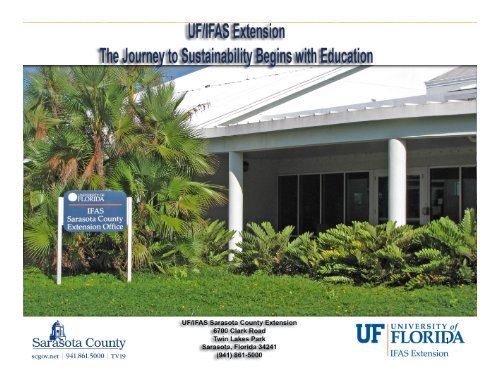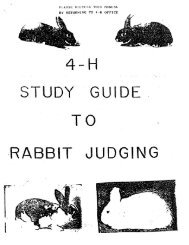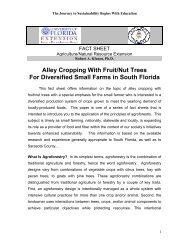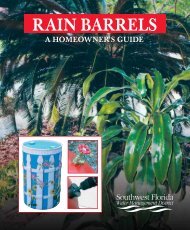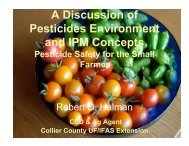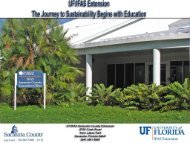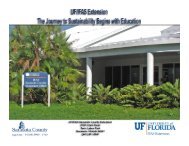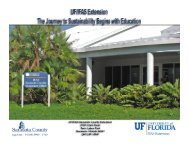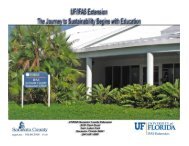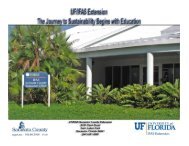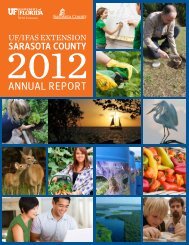Market Gardening: Food Safety; Regulations - Sarasota County ...
Market Gardening: Food Safety; Regulations - Sarasota County ...
Market Gardening: Food Safety; Regulations - Sarasota County ...
Create successful ePaper yourself
Turn your PDF publications into a flip-book with our unique Google optimized e-Paper software.
Outline• Short Review of CourseSyllabus• <strong>Food</strong> <strong>Safety</strong> Concepts andGuidelines• <strong>Regulations</strong>3
<strong>Market</strong> <strong>Gardening</strong> CourseTopics Sequence• #1: Introduction• #2: Holistic Management• #3: Business and <strong>Market</strong>ing Plans• #4: Production Systems & Planning• #5: Equipment and Tools; Post HarvestHandlingToday’s• #6: <strong>Food</strong> <strong>Safety</strong>; <strong>Regulations</strong> Topics• #7: Farmers <strong>Market</strong>s• #8: Financial Resources & Management4
<strong>Food</strong> <strong>Safety</strong>- Fresh produce offruits & vegetablesis part of a healthydiet …- <strong>Food</strong> safety requireseveryone to use smartmanagement ofgrowing and postharvestactivities . . .5
<strong>Market</strong> Garden <strong>Food</strong> <strong>Safety</strong>ProductionHarvestingProcessing for6Direct <strong>Market</strong>ing
<strong>Food</strong> <strong>Safety</strong>• What is <strong>Food</strong> <strong>Safety</strong>?– Holistic Perspective Definition• Pesticide residues &contamination– Chemical body burden• Environmental pollution impacts– Farmer and family– Farmworkers– Biodiversity– Ecosystems• Nutrition aspects– Genetically modified crops– Irradiation treatments• Pathogen contamination• Around 700 types ofcontaminants identified in fattytissues of average person.Pregnant & nursing women passthem to children . . .- Chemical Body Burden.org• FDA approves irradiation offresh spinach and iceberg lettucein an attempt to kill E. coliO157:H7 and other bacteria thatcause food-borne illnesses - Aug21, 2008• USDA Approves Irradiated Meatfor National School Lunch 7Program - May 29, 2003
<strong>Food</strong> <strong>Safety</strong>• What is <strong>Food</strong> <strong>Safety</strong>?– <strong>Food</strong> <strong>Safety</strong> Regulatory and <strong>Food</strong> IndustryPerspective Definition = TODAY’S TOPIC !• Pathogen Contamination Focus• Activities Focus– Production– Post-harvest– Processing• Onfarm <strong>Food</strong> <strong>Safety</strong> Plan Focus8
<strong>Food</strong> <strong>Safety</strong>What are foodborne illnesses?• Diseases/illness that are transmitted to humans byfood contaminated by different pathogensBacteria Fungi Parasite Virus ToxicChemicals9
<strong>Food</strong> <strong>Safety</strong>Types of Pathogen <strong>Food</strong>borne Illness• Toxin-mediated foodborne infection– illness is caused by toxin produced by a pathogeninfection (e.g., Clostridium perfringens)• Bacterial intoxication– illness is caused by toxins produced by pathogen infood prior to the consumption (e.g., Clostridiumbotulinum; Staphylococcus aureus)• <strong>Food</strong>borne infection– pathogen growth in our body after ingestion ofcontaminated food (e.g., Salmonella; Listeria)10
<strong>Food</strong> <strong>Safety</strong>• Human Host Susceptibility Factors Very young = Immature immune system Very old = Aging immune system Chronically ill = Impaired immune system11
<strong>Food</strong> <strong>Safety</strong>• Today’s foodborne illnesses result froma complex interaction of pathogens people food production & distribution systems12
<strong>Food</strong> <strong>Safety</strong>• <strong>Food</strong> <strong>Safety</strong> Regulators• Federal Level (13 <strong>Food</strong> <strong>Safety</strong> Agencies)– Cooperative State Research, Education, & Extension Services (CSREES)– Agricultural Research Service (ARS)– Economic Research Service (ERS)– Animal & Plant Health Inspection Service (APHIS)– Agricultural <strong>Market</strong>ing Service (AMS)– <strong>Food</strong> and Drug Administration (FDA)– <strong>Food</strong> and Nutrition Service (FNS)– Centers for Disease Control and Prevention (CDC)– National Institute of Health & Human Services (NIHHS)– Environmental Protection Agencies (EPA)– National Marine Fisheries Service (NMFS)– Grain Inspection, Packers & Stockyards Administration (GIPSA)• State of Florida (3 <strong>Food</strong> <strong>Safety</strong> Agencies)– Dept. of Agriculture and Consumer Affairs (FDACS), Div. of <strong>Food</strong> <strong>Safety</strong>– Dept. of Health– Dept. of Business & Professional Regulation, Div. of Hotels & Restaurants 13
FL <strong>Food</strong> <strong>Safety</strong> Regulatory AgenciesThe Florida Department of Business & ProfessionalRegulation (F-DBPR or DBPR)- Regulates restaurants, theme park food carts, caterers, vending machine (withpotentially hazardous foods), mobile food carts, food booths at festivals,carnivals and fairs.The Florida Department of Health (FDH)- Regulates public and private schools, childcare facilities, institutions(hospitals, nursing homes, community based facilities, etc.), fraternal and civicorganizations, bars and lounges, theaters, mobile units and DOH permittedfacilities. The Florida Department of Agriculture and ConsumerServices (FDACS or DACS)• Regulates retail food stores, including supermarkets, grocery stores,convenience stores, warehouses, processors in addition to minor food outlets,and mobile food units/semi-permanent vendors that limit their sells toprepackaged foods/beverages and or preparation of drinks, popcorn andbakery items. • <strong>Food</strong> processing facilities including seafood processing,bakeries, fresh sprouts and fresh juice producing facilities.14
<strong>Food</strong> <strong>Safety</strong>Potential Sources of PathogenContamination of Produce Can Be EasilyTabulated• Production factors– Environment – Wildlife– Soil/improperly composted manure – Irrigation water– Animal/human waste• Post-harvest factors– Ingredients (raw, fresh-cut produce) – Facility environment– Packaging materials – <strong>Food</strong> contact surfaces– Processing aids (air, water, ice) – Produce/<strong>Food</strong> handlers15
<strong>Food</strong> <strong>Safety</strong>However, These Sources Can Be VeryDifficult to Separate!16
<strong>Food</strong> <strong>Safety</strong>• How Big is this Issue?Statistics of <strong>Food</strong>borne Illness in the USA• Centers for Disease Control and Prevention (CDC)estimates 76 million cases of foodborne illnessannually• This includes 325,000 hospitalizations and 5,000deaths• 14 million cases caused by known pathogens and62 million cases by unknown pathogensMead et al., 1999 and CDC, 2004 17
<strong>Food</strong> <strong>Safety</strong>www.uri.edu/ce/ceec/food/documents/Intro_GAP_%202011.ppt18
Wes Kline, From Rutgers NJAgricultural Experiment StationUS <strong>Food</strong> and Drug Administration, 200719
FDA can shut down an entire industryWes Kline, From RutgersNJ AgriculturalExperiment Station20<strong>Food</strong> safety then is everyone’s concern –both big and small food production
History of FDA & USDA Responsesto Recent <strong>Food</strong> <strong>Safety</strong> Events• FDA, 2004: Produce safety from production to consumption:2004 Action Plan to Minimize <strong>Food</strong>borne Illness Associated withFresh Produce Consumtion.http:/www.cfsan.fda.gov/~dms/prodpla2.html• FDA, 2007: New guidance for safe production of fresh-cut fruitsand vegetables: http://www.cfsan.fda.gov/~dms/prodgui2.html• FDA, 2006: Lettuce <strong>Safety</strong> Initiativehttp://www.cfsan.fda.gov/~dms/lettsafe.html• FDA, 2006: Guidelines for the Fresh Tomato Supply Chainhttp://www.cfsan.fda.gov/~dms/tomatsup.html• Industry initiatives – CA, AZ 3,000 growers calling for mandatoryGAP (<strong>Food</strong> Protection Report, Nov.2006, 22(11)).www.uri.edu/ce/ceec/food/documents/Intro_GAP_%202011.ppt21
FDA/USDA Responses (con’t)• USDA, May 31, 2006. Requirement for GAP verification for allfresh products supplied to USDA programs beginning July 1,2007 with voluntary audits beginning July1, 2006. Suppliersmeeting GAP verfication listed on USDA GAP/GHP website.• CSPI, Citizen Petition, November 15, 2006. Urging FDA toissue standards and regulations to ensure safe food productionof fresh fruits and vegetables. Requesting mandatory hazardcontrol programs for farms and processors in the GAP areassuch as manure, water and sanitation.• California legislation, February 2, 2007 – Leafy greenvegetables• CA Department of <strong>Food</strong> and Agriculture, February 7, 2007 –Leafy Green <strong>Market</strong>ing Agreement – inspection program forhandlers of leafy greens certified by CDFA.www.uri.edu/ce/ceec/food/documents/Intro_GAP_%202011.ppt22
FDA/USDA Response (con’t)• FDA, June 12, 2007. Tomato safety initiative to reducetomato-related foodborne illnesses due to Salmonella. Tobegin with VA farms and packing facilities as to degreeimplement GAP and GMP’s.• FDA, September, 2008. Original guidance documentrevisited for updating in response to 10 years of outbreaks.• <strong>Food</strong> <strong>Safety</strong> Enhancement/Modernization Acts 2009.Proposed, House and Senate. Incorporates all food products.Proposed requirement for food safety plans and/or standardsfor fresh produce.• FDA, 2/23/2010: Request for comments on preventivecontrols for fresh producewww.uri.edu/ce/ceec/food/documents/Intro_GAP_%202011.ppt23
FDA <strong>Food</strong> ModernizationAct of 2010New <strong>Food</strong> <strong>Safety</strong> Standardsand <strong>Regulations</strong>: Impact onthe Produce Industry at allScales of Productionwww.uri.edu/ce/ceec/food/documents/Intro_GAP_%202011.ppt24
Some Key Expectations• Registration and re-registration• Produce <strong>Safety</strong> Standards – GAP/<strong>Food</strong> <strong>Safety</strong> Plan atHarvest: High risk foods?• Preventive Control <strong>Food</strong> <strong>Safety</strong> Plans for processors,wholesalers and distributors (HAACP-type)• Flexibility for small farmers and businesses• <strong>Food</strong> defense as part of plan• Records• Traceability provisions• Impact at retail – FDA reportable food registry• FDA Mandatory recall authority• Other – Importer accountability, inspections, 3 rd party etc.25www.uri.edu/ce/ceec/food/documents/Intro_GAP_%202011.ppt
Produce <strong>Safety</strong> Standards• Address growing, harvesting, sorting,packing/storage• Science-based minimum standards for– Soil amendments– Hygiene– Packaging– Temperature controls– Animals– Water• High Risk Produce - prioritizewww.uri.edu/ce/ceec/food/documents/Intro_GAP_%202011.ppt26
Produce <strong>Safety</strong> Standards -Timeline• Proposed rule = 1year• Final rule = 1 year• Phase in for Farmers– Large farms - immediately– Small farms – 1 year from regulations– Very small farms – 2 years from regulations• What will the standards look like– Some kind of food safety plan, based on GAP– ? 27www.uri.edu/ce/ceec/food/documents/Intro_GAP_%202011.ppt
Preventive Controls –HACCP-type• Hazard evaluation for reasonable biological,chemical, physical, pesticide etc. hazards -written• Include bio-security issues• Implement preventive controls to prevent,minimize or eliminate hazard - CCP• Includes sanitation, training, recalls, GMPs etc.• Monitor controls, Corrective Actions,Records, Verification steps to make sureplan working 28www.uri.edu/ce/ceec/food/documents/Intro_GAP_%202011.ppt
Preventive Controls – Timeline• Proposed rule = 9 months• Implementation = 1.5 years• Large farms =• Small farms =immediately6 months fromeffective regulation date• Very small farms = 18 months from effectiveregulation date• What will the FDA regulations look like?– Seafood HACCP and Juice Regswww.uri.edu/ce/ceec/food/documents/Intro_GAP_%202011.ppt29
Flexibility for Small Farmers• Produce safety standards– 3 yr average sales < $500,000 ALL food– Distribution intrastate or within 275 mi. radius– Majority distribution end-users e.g. directly tocustomers, restaurants or retail food (NOdistributors)– Product label: name/place business, if no labelprovided through placard at a retail, for example– Exemption can be withdrawn by FDA withreason of contaminationwww.uri.edu/ce/ceec/food/documents/Intro_GAP_%202011.ppt30
Flexibility for Small Businesses• Preventive Controls/<strong>Food</strong> <strong>Safety</strong> Plans– Exclusions:• FDA must define small and very small business• Warehouses storing raw agricultural commodities forfurther processing• Facilities subject to produce safety standards• Processors subject to other HACCP regulations• Dietary supplements• Alcohol-related facilitieswww.uri.edu/ce/ceec/food/documents/Intro_GAP_%202011.ppt31
Flexibility for Small Businesses• Preventive Controls/<strong>Food</strong> <strong>Safety</strong> Plans– Exemptions (still must register)• 3 yr average sales < $500,000 ALL food• Distribution intrastate or within 275 mi. radius• Majority distribution end-users e.g. directly tocustomers, restaurants or retail food (NO distributors)• Product label: name/place business, if no labelprovided through placard at a retail, for example• Must document applying controls or incompliance with other state, local requirements– Exemption can be withdrawn by FDA withreason of contaminationwww.uri.edu/ce/ceec/food/documents/Intro_GAP_%202011.ppt32
Flexibility But……Buyers Requirements:<strong>Food</strong> safetyapplies to allsizes!www.uri.edu/ce/ceec/food/documents/Intro_GAP_%202011.ppt33
<strong>Food</strong> <strong>Safety</strong> For <strong>Market</strong> GardensGood Agricultural Practices (GAPs)• a set of recommendations that can helpimprove the quality and safety of theproduce grown• can be adapted and/or incorporated intoany production system• focus on four primary components ofproduction and processing: soil, water,hands, and surfaces• develop a food safety plan for youroperation as a roadmap for activelyreducing risks that may jeopardizeproduct safetyNational GAPs Educational Materials Cornell University34
<strong>Food</strong> <strong>Safety</strong> For <strong>Market</strong> GardensFarm <strong>Food</strong> <strong>Safety</strong> Plan/ManualOnline Resources• USDA On-Farm <strong>Food</strong> <strong>Safety</strong> Projecthttp://onfarmfoodsafety.org/• National GAPs Educational Materials CornellUniversityhttp://www.gaps.cornell.edu/gapsd/EdumtrlsEng.html• Primus Labs online manualwww.primuslabs.com35
<strong>Food</strong> <strong>Safety</strong> For <strong>Market</strong> GardensUSDA On-Farm <strong>Food</strong> <strong>Safety</strong> Project• A free and voluntary online tool for a comprehensive food safetyprogram developed for small & mid-scale farmers, especially forselling into wholesale markets• To generate a food safety plan using the tool, a producer mustanswer a series of questions online -- on a variety of areas,including worker health and hygiene, previous land use, pestcontrol, packinghouse activities, and product transportation• Provides the following technical assistance• onfarm safety plans• training program for employees• record keeping tools to document a food safety program• preparation for GAP certification36
<strong>Food</strong> <strong>Safety</strong> For <strong>Market</strong> GardensUSDA On-Farm <strong>Food</strong> <strong>Safety</strong> Project -Background• Coordinated by USDA “Know Your Farmer, Know Your<strong>Food</strong> Program” to support safe local foods directmarkets• Developed with funding from USDA's RiskManagement Agency (RMA)• Supported by large buyers, which usually require GAPfood safety certification, including, Compass Group,SYSCO, and Chipotle Mexican Grill37
<strong>Food</strong> <strong>Safety</strong> For <strong>Market</strong> GardensUSDA On-Farm <strong>Food</strong> <strong>Safety</strong> Project* How to Get <strong>Food</strong> <strong>Safety</strong> Certified *Step 1: DEVELOP A FOOD SAFETY PLANStep 2: IMPLEMENT THE PLANStep 3: THE FOOD SAFETY AUDIT38
<strong>Food</strong> <strong>Safety</strong> For <strong>Market</strong> GardensP.A.C.E. Principles = Approach• Taken from UF/IFAS interactive training program ‘SmallFarm <strong>Food</strong> <strong>Safety</strong>: Fresh Produce’ which introduces foodsafety concepts as applied to fresh produce.• Based on small farm application of FDA's Guide toMinimized Microbial <strong>Food</strong> <strong>Safety</strong> Hazards for Fresh Fruitsand Vegetables (FDA-GAPs).• Each letter in PACE represents an important idea forreducing microbial contamination.• Current technologies cannot eliminate all potential foodsafety hazards associated with fresh produce that will beeaten raw.• Therefore, aim is for risk reduction, not risk elimination.39http://edis.ifas.ufl.edu/fy966
<strong>Food</strong> <strong>Safety</strong> For <strong>Market</strong> Gardens• P.A.C.E. Principles40
<strong>Food</strong> <strong>Safety</strong> For <strong>Market</strong> Gardens41
<strong>Food</strong> <strong>Safety</strong> For <strong>Market</strong> GardensP.A.C.E. Principles – Videos• UF/IFAS interactive training program ‘SmallFarm <strong>Food</strong> <strong>Safety</strong>: Fresh Produce’• Video #1 – “In The Field”• Video #2 – “The Packing Shed”• Video #3 – “In The Truck”http://edis.ifas.ufl.edu/fy96642
<strong>Food</strong> <strong>Safety</strong> For <strong>Market</strong> GardensP.A.C.E. Principles –Example Tools• Farm Activities Map- illustrate the physical characteristics of yourmarket garden operation- identify potential contamination points in yourmarket garden operation• <strong>Food</strong> <strong>Safety</strong> Plan- list the most important food safety practices toteach workers in order to avoid potentialhazards of pathogen contamination43
<strong>Food</strong> <strong>Safety</strong> For <strong>Market</strong> Gardens• FarmActivitiesMapExample• IdentifyHazardsAndSolutionsAt EachStationhttp://edis.ifas.ufl.edu/fy96944
<strong>Food</strong> <strong>Safety</strong> For <strong>Market</strong> GardensP.A.C.E. Principles – Example Guidelines• Production Activities- only use well-composted manure and isolate treatmentareas away from fresh produce fields.-the quality of water contacting edible portions of a plantmust be high and the water should be tested forbacteria, protozoa and viruses. Water applied to cropsfor other purposes (frost protection and pesticideapplication) must also come from a safe source.- proper hygiene procedures should be established andincluded in hygiene and health training programs of allemployees.- keep records of safe fertilizer, watering and siteselection procedures followed 45
<strong>Food</strong> <strong>Safety</strong> For <strong>Market</strong> GardensP.A.C.E. Principles – Example Guidelines• Harvest Activities– avoid contact between fruits, vegetables, bins, etc.and the soil.– avoid bruises or cuts to the fruits or vegetables thatmay allow internal contamination.– do not use open water sources for field washing.– clean and sanitize bins and harvest equipment beforeeach use.– provide restrooms and hand-washing stations.46
<strong>Food</strong> <strong>Safety</strong> For <strong>Market</strong> GardensP.A.C.E. Principles – Example Guidelines• Post-Harvest Activities• when produce from many fields come together, any errorspreharvest can contaminate clean uninfected fruit at postharvest- keep dirty fruit from the field separated from the clean,packed fruit. Wash dirty fruit separately.- handle produce carefully to prevent wounds. Removeinjured product and discard fruit that fall on the floor.Remove cull fruit and debris promptly.- wash your hands!- wear gloves when touching produce.- triple-wash leafy vegetables.47
<strong>Food</strong> <strong>Safety</strong> For <strong>Market</strong> GardensP.A.C.E. Principles – Example Guidelines• Post-Harvest Activities (continued)- know the quality of water used for washing and test forbacteria, protozoa and viruses.- clean and sanitize packing areas, storage rooms, fruitbins and equipment regularly.- temperature control is important. Low temperaturessupplement good sanitation practices. Avoid delays thatpostpone cooling.- keep animals (including pets) away from vegetables--especially after the produce has been washed.- be aware of microbial sources and avoid crosscontamination.48
<strong>Food</strong> <strong>Safety</strong> For <strong>Market</strong> GardensP.A.C.E. Principles – Example Guidelines• Room and Equipment Cleaning Procedures• Empty and sweep cold rooms• Pre-rinse equipment or walls• Visually inspect surfaces• Apply appropriate cleanser (scrub from top, downward)• Do not allow cleanser to dry on surfaces (rinse from top,downward)• Visually re-inspect surfaces• Apply a high level sanitizer (800 ppm quaternary ammonia)• Let stand for 20 minutes• Rinse with potable water• Apply regular level sanitizer (200 ppm quaternary ammonia)• Rinse with potable water• Always rinse ammonia products before adding chlorine (e.g.49dump tanks)
<strong>Food</strong> <strong>Safety</strong> For <strong>Market</strong> GardensThe Importance of Record Keeping• Documentation highlights a grower’s commitmentto produce safety by reducing microbial risks to fruitsand vegetables.• When foodborne illness outbreaks occur, attemptsare made to trace the contamination back to thepoint of origin.• Documenting movement of a food crop from thefield to the farm gate, worker health, worker trainingprograms, building sanitation, and equipmentmaintenance may provide important data indetermining the origin of the contamination.50National GAPs Educational Materials Cornell University
<strong>Food</strong> <strong>Safety</strong>Sample of Different Comments to <strong>Food</strong> <strong>Safety</strong>Issues and Benefits of Locally Grown <strong>Food</strong>s• One of the main challenges in boosting produce food safetyalong the entire supply chain is identifying and monitoring thevariety of paths that the food can take from the farm to theconsumer. The process is “hugely complicated.”• Perhaps locally grown food, with a focus on organicguidelines and sustainability is a step toward greater foodsafety.• The future of sustainable agriculture has never looked morepromising -- or more challenging.• “No Local Farms, No Safe <strong>Food</strong>.”--- Hobby Farms News – <strong>Food</strong> 911 (2008) 51
<strong>Food</strong> <strong>Safety</strong>• Example Issues for Small & Diversified Farms• GAPs and related issues need to be evaluated as solutionsby considering their full context.• <strong>Food</strong> safety change now is a push down the supply chain tothe farmers who supply processing plants that have had foodcontamination problems. Farmers for local food markets arenot part of this distribution system.• In these efforts to keep bacteria out of the food supply, theFDA, USDA, and various other agencies, large foodprocessors, and food buyers are on the verge of creating asystem that would essentially prevent farmers from raisingboth livestock and crops for human consumption on the samefarm, or in the same neighborhood.Maine Organic Farmers and Gardeners Associationhttp://www.mofga.org/Default.aspx?tabid=73552
<strong>Food</strong> <strong>Safety</strong> Impact In Perspective• 2006 Cancer deaths543,000 (30% lung cancer)• CDC reported in July 2009 “Hospital Acquired Infections”1.7 million people get sick each year99,000 people die of these infections each year• 2006 Automobile incidents:6.42 million accidents– about 2.9 million injuries42,642 deaths• 2003 deaths related to firearms (non-war related)29,000 deaths• 2006, CDC reported325,00 hospitalizations of food borne illness5,000 deaths53
<strong>Food</strong> <strong>Safety</strong> <strong>Regulations</strong>FL Small Famers’ Perspectives• see video athttp://www.gainesville.com/article/20090501/VIDEO/90501200154
FL <strong>Food</strong> <strong>Safety</strong>-Based <strong>Regulations</strong>for Direct <strong>Market</strong> Sales• Summaries of regulations – see--http://smallfarms.ifas.ufl.edu/floridasmallfarmsconference/postconference/2009/presentations/policy_regulations/direct_marketing/burbaugh.pdfhttp://edis.ifas.ufl.edu/fy1225• FDACS response to reform requests in 2010Report: SMALL FARMS: Recommendations toMinimize Costs While Ensuring <strong>Food</strong> <strong>Safety</strong> -see http://www.freshfromflorida.com/fs/SmallFarms2011B.pdf• FL Cottage <strong>Food</strong> Law –see http://www.freshfromflorida.com/fs/ 55
General <strong>Regulations</strong>• Contrary to popularbelief agriculture is notexempt from regulations.• The costs associatedwith regulations havebeen identified as amajor obstacle tostarting and operating asmall farming operation56
<strong>Regulations</strong> Information Sources• UF/IFAS Small Farm & Alternative EnterpriseProgram – see http://smallfarms.ifas.ufl.edu/– Legal aspects of regulations• UF Center for Agribusiness, UF/IFAS <strong>Food</strong>and and Resource Economics Department –see http://www.fred.ifas.ufl.edu/agbuscenter/– Website has links of the following:• Business resources• Agriculture resources• Data resources57
Start-Up ConsiderationsGeneral Business Issues• Business Organization Type – Sole Proprietor,Partnership or Corporation• Fictitious Name Registration – If your business will useany name other than the owners’ legal name or fullcorporation name then a fictitious name registration isrequired.Agency:Florida Department of StateDivision of Corporations(800) 755-5111• Employer Identification Number (EIN) - Also known as aFederal Tax Identification Number, and is used to identify abusiness entity. Generally, businesses need an EIN.Agency: IRS, (800) 829-493358
<strong>Regulations</strong>Occupational License• An occupational license is a privilege tax toengage in or manage any business, profession,or occupation within a particular jurisdiction.• FL Right to Farm Act exempts producers ofagricultural products from occupational licensesas long as all products being sold were grown orproduced by the farmer.• Any person who buys, receives, solicits, handles,or negotiates ag products from producers mustbe licensed and bonded.Agency: FDACS, Divison of <strong>Market</strong>ing & Development(850) 488-410159
Florida Right to Farm ActThe law (F.S. 823.14) states that agriculturalactivities conducted on farm land in urbanizingareas are potentially subject to lawsuits basedon the theory of nuisance and that these suitsencourage and even force the prematureremoval of the farm land from agricultural use. Itis the purpose of this act to protect reasonableagricultural activities conducted on farm landfrom nuisance suits.60
<strong>Regulations</strong>Zoning• Most agricultural uses canonly occur on AgricultureZoned property.• Commercial production ofproduce can be grown on nonagriculturalland as long as thesales are offsite.• Consultation with Zoning officeof food production plans arehighly recommended.Agency: <strong>Sarasota</strong> <strong>County</strong> Planning and Development Services(941) 861-500061
<strong>Regulations</strong>Land Alteration <strong>Regulations</strong>Natural Resource Permits– Tree removal– Land Clearing– Earthmoving (Excavating, Filling, Grading)– Natural habitatsActivities such as these typicallyrequire a permit from the countyunless otherwise exempt.Agency: <strong>Sarasota</strong> <strong>County</strong> Planning and Development Services(941) 861-500062
<strong>Regulations</strong>Well & Water Permitting• Consumptive Water Use Permit (WUP) -Required for all wells of 6 in. diameter or larger orcapable withdrawing 100,000 gallons per day onan annual average basis or 1,000,000 gallons onany single day.• Well Construction Permit (WCP) - Required forthe construction of all new wells that are greaterthan 2 in. diameterAgency: Southwest Florida Water Mgt District(352)796-7211 or (800)423-1476www.swfwmd.state.fl.us63
<strong>Regulations</strong>Building Permits• Nonresidential “farmbuildings” are exempt fromthe Florida Building Codesand any county ormunicipal building code.• Most jurisdictions requirenotification to the county orcity Building Department.• Signs need permitting.Agency: <strong>Sarasota</strong> <strong>County</strong> Planning and Development Services(941) 861-5000 64
<strong>Regulations</strong>Nursery Inspection• All nurseries MUST beinspected and registeredwith the Division of PlantIndustry prior to selling anyplants• If your business requiresan occupational licenseyou must be registered withDPI prior to getting anoccupational license.Agency: Florida Department of Agriculture and ConsumerServices Division of Plant Industry65
<strong>Regulations</strong>Pesticide Licensing• If you are going to apply restricted usepesticides on your market garden a PrivateApplicators License is required.• Worker Protection Standard - A federalregulation designed to protect agriculturalworkers and pesticide handlers.see http://edis.ifas.ufl.edu/pi150More Information: FDACShttp://www.freshfromflorida.com/onestop/aes/pestapp.html66
<strong>Regulations</strong>Best Management Practices• Growers that implementthe appropriate voluntaryState adopted BMPsreceive a presumption ofcompliance with statewater quality standards.• Manuals have beencompleted or are availableonline athttp://www.floridaagwaterpolicy.com/BestManagementPractices.htmlContact: Office of Agricultural Water Policy, FDACS (850) 488-624967
<strong>Regulations</strong>Agricultural Classification• The Agricultural Classification, commonlyreferred to as the "green belt" assessment, whilenot an exemption, may result in lower propertytax bills for qualified property owners.• The agricultural use classification should not beconfused with zoning. If your land is used for abona fide commercially viable operationproducing an agricultural product that is activelymarketed, you may request an agricultural filingat the Property Appraiser's Office.Agency: <strong>Sarasota</strong> <strong>County</strong> Property Appraiser (941) 861-820068
ACKNOWLEDGMENTSAmy SimonneDepartment of Family, Youth and Community SciencesIFAS, University of Florida“<strong>Food</strong> <strong>Safety</strong> Considerations for Small Farmers”Stephen GranManager – Agriculture Industry DevelopmentHillsborough <strong>County</strong> Economic Development Department“Agriculture <strong>Regulations</strong> Overview”69
<strong>Market</strong> <strong>Gardening</strong> <strong>Food</strong> <strong>Safety</strong> &<strong>Regulations</strong> Online Resources• Best Management Practices, Office of Water Policy, FDACShttp://www.floridaagwaterpolicy.com/BestManagementPractices.html• Center for <strong>Food</strong> <strong>Safety</strong>http://www.centerforfoodsafety.org/index.cfm• Chemical Body Burden Websitehttp://www.chemicalbodyburden.org/• EDIS Small Farm <strong>Food</strong> <strong>Safety</strong> Series Publicationshttp://edis.ifas.ufl.edu/TOPIC_SERIES_Small_Farm_<strong>Food</strong>_<strong>Safety</strong>• Florida Dept. of Agriculture and Consumer Affairs,Division of <strong>Food</strong> <strong>Safety</strong>http://www.doacs.state.fl.us/fs/other.htmlDivision of <strong>Market</strong>ing and Developmenthttp://www.florida-agriculture.com/marketing/licensing/index.htmDivision of Plant Industrieshttp://www.doacs.state.fl.us/pi/• Guide to Good Agricultural Practices (GAPs), ISUhttp://www.extension.iastate.edu/Publications/PM1974A.pdf• Hobby Farm News – <strong>Food</strong> 911http://www.hobbyfarms.com/farm-industry-news/food-911.aspx 70
<strong>Market</strong> <strong>Gardening</strong> <strong>Food</strong> <strong>Safety</strong> &<strong>Regulations</strong> Online Resources• Iowa State Extension, Farm <strong>Food</strong> <strong>Safety</strong> Resourceshttp://www.extension.iastate.edu/foodsafety/resources/index.cfm?listID=4• National GAPs Educational Materials, Cornel Univ.http://www.gaps.cornell.edu/farmassessmentws.html• <strong>Sarasota</strong> <strong>County</strong> Property Appraisal Office, Agricultural Classificationhttp://www.sarasotaproperty.net/agricultural_defined.asp• University of CA, Small Farm Center, <strong>Food</strong> <strong>Safety</strong> Education,Rangarajan, A. et. al., 1999. <strong>Food</strong> <strong>Safety</strong> Begins on the Farmhttp://www.sfc.ucdavis.edu/docs/foodsafety.html• UF Center for Agribusiness, UF/IFAS <strong>Food</strong> and and Resource EconomicsDepartment http://www.agbuscenter.ifas.ufl.edu/• UF/IFAS/FAMU Small Farm & Alternative Enterprise Program <strong>Food</strong> <strong>Safety</strong>Publications Burbaugh, B. Direct <strong>Market</strong>ing <strong>Regulations</strong>http://smallfarms.ifas.ufl.edu/floridasmallfarmsconference/presentations/policy_regulations/direct_marketing/burbaugh.pdfRitenour, M. Production and Post-Harvest <strong>Safety</strong>http://smallfarms.ifas.ufl.edu/planning_and_management/farm_safety.html• UF/IFAS <strong>Food</strong> <strong>Safety</strong> Website http://foodsafety.ifas.ufl.edu/• UF/IFAS Small Farm <strong>Food</strong> <strong>Safety</strong> Serieshttp://edis.ifas.ufl.edu/topic_series_small_farm_food_safety• US National <strong>Food</strong> <strong>Safety</strong> Programs Website http://www.cfsan.fda.gov/~dms/fs-7toc.html
Online Reading Assignments• UF/IFAS Small Farm and Alternative Enterprise ProgramPublications – see Direct <strong>Market</strong>ing section, UF/IFASPublications– Farmers <strong>Market</strong> Serieshttp://smallfarms.ifas.ufl.edu/planning_and_management/marketing.html• ATTRA Publications– <strong>Market</strong> <strong>Gardening</strong>: A Start-Up Guidehttp://attra.ncat.org/attra-pub/marketgardening.html– Farmers <strong>Market</strong>shttp://attra.ncat.org/attra-pub/farmmrkt.html72


